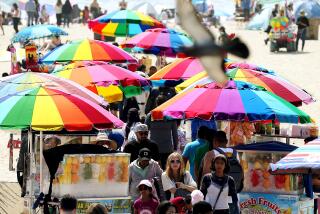Cancer Rates to Triple in Those Over 75
- Share via
Cancer incidence is expected to double during the next 50 years for Americans, and the greatest burden will be among those 75 and older, whose cancer rates will nearly triple because of their unprecedented ranks in the population, according to a report released last week.
The number of people who will develop some form of cancer will rise from the current 1.3 million people per year to 2.6 million by 2050. The increases, which are expected to occur steadily in the coming decades, are because of a large aging population that will live longer and ultimately encounter cancer, medical experts predict.
“Cancer is a disease of aging,” said Dr. Michael Thun, who heads epidemiologic research for the American Cancer Society. “With longevity people will live into the ages when cancer is more likely to occur.”
The report, which appears in the current issue of Cancer, a publication of the American Cancer Society, is a joint research effort of the society, the National Cancer Institute, the Centers for Disease Control and Prevention and the North American Assn. of Central Cancer Registries.
News of the rising number of diagnoses comes even as the same group of researchers found that cancer incidence continued on a steady decline that began in 1973. Researchers used 2000 census data and current information on cancer incidence rates to project what the cancer picture will be like during the next 48 years.
Dr. Brenda Edwards, associate director of surveillance programs at the cancer institute and chief author of the report, said the leading cancer types in the next half-century will be the same as today’s: lung, breast, prostate and colon.
“We are aging faster than our improved abilities of diagnosis and treatment,” Edwards said. She underscored that treatment strategies in the coming years, however, will help older people live longer, productive lives.
The population of people most likely to develop cancer are those 75 and older. By 2050, more than 1.1 million people in that age group will develop some form of the disease each year. Currently, that number is 400,000 per year.
Thun said much of the increase will be because of unprecedented demographic trends.
Between now and mid-century, for example, people 85 and older are expected to have increased fourfold. As people age, the report underscored, so too will their need for cancer treatment services.
Researchers said more doctors will be needed to treat the growing number of cancer patients. Already, cancer centers and medical schools are bracing for the increase.
“We’re putting a huge focus on this patient population,” said Dr. Arti Hurria, a geriatric oncologist at Memorial Sloan-Kettering Cancer Center in Manhattan. “One thing that is happening now is that we are training people in both fields.” Hurria was referring to geriatrics, the specialty that focuses on people 65 and older, and oncology, the area of medicine that centers on cancer treatment.
Hurria said the plan is to focus on patients’ functional age: that is, their level of independence and individual physical strengths.
“We’re trying to get away from looking at chronological age alone because two 75-year-olds can be very different people,” she said.
Dr. Norman H. Edelman, vice president of the health sciences center and dean of the medical school at SUNY Stony Brook, said the school has just received funding for a geriatric education center, which will be run out of its department of medicine.
“This is a program conducted throughout the entire school of medicine,” he said. “We’re training people in all areas, and cancer is a major part of this.”
Geriatric-focused medicine is important, he said, because it zeroes in on the specific needs of patients.
*
Delthia Ricks is a reporter for Newsday, a Tribune company.






